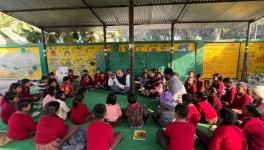NFHS 5 Survey Data: Nothing “Uttam” About Uttar Pradesh
After a delay of about a year, the National Family Health Survey (NFHS) 5 data for Uttar Pradesh and a few other states was released by the government on November 24, 2021. The data paints a grim picture of people’s health in the Bharatiya Janata Party ruled state.
Amidst an effort to project Uttar Pradesh as an “Uttam Pradesh”, the data on child malnutrition and anaemia shows that the state is failing its children.
The percentage of children under five years who are severely wasted has increased in UP from 6% in 2015-16 to 7.3% in 2020-21. The percentage of children aged 6-59 months who are anaemic has also increased from 63% to 66% over the same period.
Although the indicators on stunted and wasted children show marginal improvements, a recent response from the Women & Child Development Ministry to an RTI query from The Hindu notes that UP is home to nearly 1.86 lakh malnourished children.
Data for UP also shows an increase in the percentage of anaemic women aged 15-19 years. The prevalence of obesity has also increased in 2020-21 as compared to 2015-16 with proportion of obese people (in all categories - men, women and children) increasing substantially in UP.
The Phase 1 data for other 22 states and union territories was last released in December 2020.
UP Performing Below India Average
In comparison to India’s average, UP remains a laggard state in many of the important health indicators. Table 1 below shows some of these indicators in which UP has fared poorly than the national average.
Although there is a decline in IMR in UP as compared to NFHS 4 data, but looking at the India average, UP severely underperforms. It is a matter of serious concern that in UP, nearly 50 children die per 1000 live births. For India, on an average, this figure is 35. The National Health Policy (NHP) brought out in 2017 had targeted to nationally reduce IMR to 28 by 2019. The latest data shows that not only has India missed the target, but UP fares much poorly.
Similarly, U5MR is much higher in UP as compared to India. In UP, nearly 60 children per 1000 live births die below five years of age; for India this figure is about 42. The NHP targets reducing U5MR to 23 by 2025, but clearly the current levels are discouraging.
The indicators of malnutrition are alarming in the northern state as well. There are about two stunted children in every five children (under five years of age) in UP (40%). The share of wasted children (under five years of age) in UP stands at 17%.
Differing Healthcare Figures Cast Doubt!
The NFHS-5 Survey for UP was done in two phases between January 2020 and April 2021 – the period coinciding with the pandemic and the national lockdown. The NFHS-5 data shows a high proportion of children getting the BCG vaccination during this period with about 93% of children receiving immunisation. On other counts also, such as ante-natal care the performance is better.
However, some studies have pointed out and recorded (here and here) that during this period, the delivery of health services was adversely affected. There was widespread closure of Anganwadis which disrupted services such as child immunisation and ante-natal care (ANC).
A study by Jean Dreze and Vipul Paikra shows that in states such as UP, where the health services are already in a poor condition in normal times, the period of lockdowns during 2020 witnessed a collapse of these services. They studied the Health Management Information System data and compared the April-May 2020 average as a ratio of the January-February 2020 average, and also the April-May 2020 average as a ratio of the April-May 2019 average.
According to their estimates, UP along with Bihar and Jharkhand, experienced the most severe decline in delivery of healthcare services. In their composite index, which includes ANC registrations by pregnant women and BCG vaccination for children, the decline in health services was about 70% in UP (56% in ANC registrations and 61% in BCG vaccinations).
In UP, there has been a deterioration in some key indicators such as child wasting and anaemia over the years. The improvement in others has been rather slow over the past five years (between NFHS 4 and 5).
Dipa Sinha, faculty at Ambedkar University, Delhi and a health activist, suggests that “the improvement shown in such indicators as child stunting could be a base year effect as UP is a high-prevalence state. And stunting is a longer-term indicator which needs to be looked from the perspective of the mothers’ health also.”
A detailed analysis of the district-wise data would give more insights into the region-wise performance in UP. However, the overall data does show that there is nothing to boast about in UP as far as basic health indicators such as malnutrition are concerned. In comparison to the national average, UP is an under-performer. To genuinely transform it into an “Uttam” Pradesh, it would require more work and less hyperbole on the part of the state government.
Get the latest reports & analysis with people's perspective on Protests, movements & deep analytical videos, discussions of the current affairs in your Telegram app. Subscribe to NewsClick's Telegram channel & get Real-Time updates on stories, as they get published on our website.
























